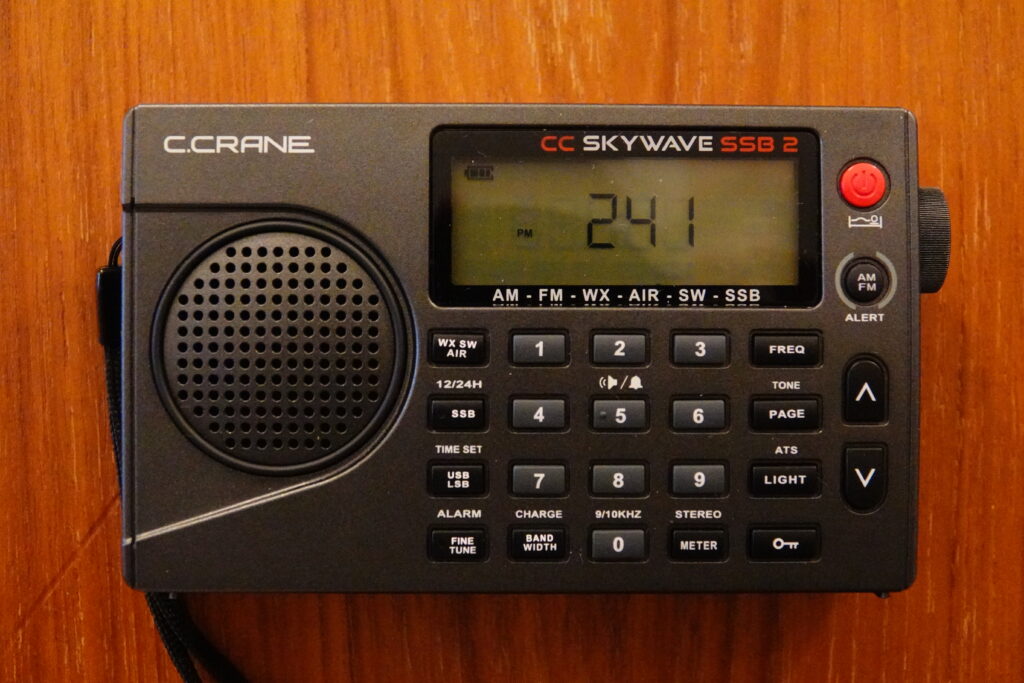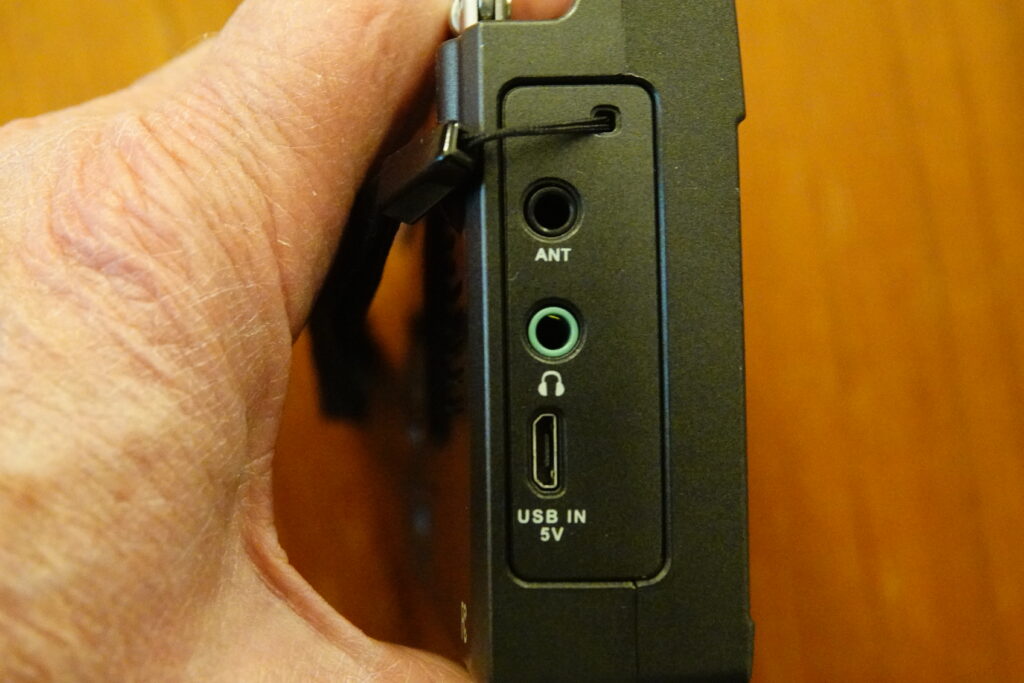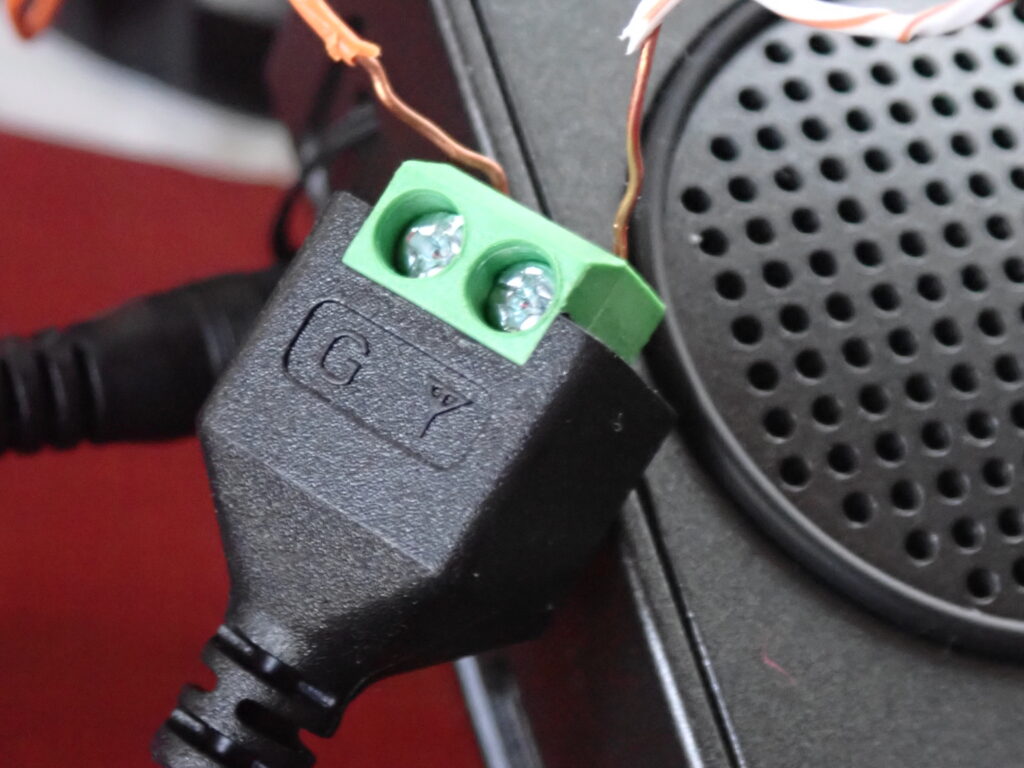By Jock Elliott, KB2GOM
Frequently when people write about attaching a long wire to a portable shortwave receiver, readers will comment that you need to worry about desensitizing or overloading the receiver or ever harming the front end of the receiver. Clearly that can be a concern.
But recently I noticed something on the CCrane website in the FAQ section that shows clearly that CCrane has thought about and dealt with this consideration:
Q: When using the 2-wire adapter and wire attached, why am I not noticing any improvement on shortwave?
A: To see any difference using the 2-wire adapter you will need to have a wire that is more than 30 feet long (we recommend 60-100’) with a good ground wire. Insulated wire will last longer and should be stranded so it is more flexible. If you do not have a good ground, you are actually inputting noise. If you look at the 2-wire adapter (included) you will see an antenna icon and a ground (G) marking. You need to connect them properly when using an external antenna. When a plug is inserted into the antenna jack of the radio the internal rod antenna is disconnected. (See page 30 of the Instruction manual.)
If you check out my review of the CCrane Skywave SSB 2 you will read that I heard a noticeable improvement when connecting the SSB 2 to a 45-foot end fed wire.
Note, though, that if you plan to attach a wire to the SSB 2’s whip antenna, use the 23-foot reel antenna that comes with the radio.




The best portable antenna I have ever used is the Kiwa “Pocket Loop.”
https://web.archive.org/web/20000208022320/https://www.kiwa.com/odxarvw.html
By twisting the loop it packs down small.
S/N is good, has some resistance to RFI, gain is adjustable, and it is directional.
It was expensive when new,
but since Craig no longer makes or sells it,
perhaps someone should make a “knock off,”
perhaps the Belka guy in Belarus?
It is quite good on MW too.
Brilliant idea. Reading about copper clad spring wire seems a bit expensive to make now. Perhaps painting regular stainless spring wire with copper paint would work?
With my Tecsun PL-880 and Belka-DX receivers, here in New Brunswick, Canada, I typically use the 7-metre Tecsun reel antenna plugged into the external antenna jack without a balun, operated outdoors 40 metres away from my house — even in winter, snowshoes required! 😉 Without a ground or counterpoise. I typically have a low noise floor with these sensitive receivers and can get good weak signal reception. For example, last weekend I had a fair signal from LRA36 in Antartica, which runs 1500 watts or less! Also, I usually get some of the best reception in North America for the annual BBC Midwinter broadcast to Antarctica. So, a long antenna is not necessarily needed for SW reception.
IIRC, testing back in the day the US Navy determined a 6′ vertical provides acceptable HF reception performance, and that was with period hardware. As to whether that was RF grounded to a ship or not…. hmmm.
Anyway, it is ultimately about signal-to-noise (SNR), and you seem to have a low noise location. Congrats! 🙂
A large steel boat in salt water should make an ideal counterpoise!! ?
I like the Loop-on-Ground for portable use. My latest version uses 3-conductor wire and only around 8 1/2 feet in diameter with good signal/noise ratio. However, it does need an amplifier at the feedpoint. See my article from last week.
I made my own Random wire EndFed UNUN from a blog posting I saw. Search for – 9:1 Magnetic Longwire Balun / Unun – M0UKD – Amateur Radio Blog
It hears signals well but is a bit noisy. It is not hard to make and much cheaper than Palomar Engineers’ $80 version.
Nature likes pairs and an antenna is no different. The counterpoise is effectively the mirror image of the signal being received (or transmitted if you are an amateur radio operator). So, with an Unbalanced longwire, I would recommend using a counterpoise on an UnUn (unbalanced longwire to unbalanced coax). Your own body is a counterpoise if you hold the radio in your bare hands. Same thing with a magnet mount antenna using the body of the car/truck. M0UKD’s diagram is an UnUn and used with longwires. And, you don’t need planet earth dirt ground, just a counterpoise wire should work well.
A loop or dipole fed in the middle uses a Balun (Balanced loop or dipole to Unbalanced coax). A Balun is wired slightly differently (I forget exactly how). .Sometimes these terms and their configuration gets confused.
^THIS. 🙂
Even an end-fed wire antenna still is subject to Kirchhoff’s current law.
https://en.wikipedia.org/wiki/Kirchhoff%27s_circuit_laws
——————–
For our purposes the “end-fed” antenna is really an extremely offset off-center-fed dipole (OCFD). The other “side” of the antenna is going to couple to something, but it a counterpoise wire, nearby metal object(s), and/or especially the coaxial feedline.
If using a popular 9:1 unun, use an 1:1 RF choke at approximately 1/4-wavelength of the lowest operating frequency (within reason) down the feedline. A few turns of coax on a mix 31 or 43 toroid should be okay.
Optimizing turns ratios for various LW/MW/HF bands:
http://www.karinya.net/g3txq/chokes/
BTW about choke placement, since we are not fine tuning a transmitting antenna, pretty much anywhere between the house (or receiver if in the field) up to at least least few feet from the feedpoint is likely to suffice for basic common mode mitigation.
If know the following is more about transmitting, but to cover the bases, i using is a 49:1 or 64:1 unun to make an end-fed half-wave dipole (EFHW) for optimizing select harmonically-related bands, the RF choke placement could be as close as 1/8w or potentially even 1/16w from the feedpoint and work decently enough for common-mode mitigation. That said, an 4:1 or 9:1 unun tends to be the “better compromise” for most receiving end-fed antennas fed with coaxial feedline.
——————–
Now as to my what I have been doing with ununs in recent times. Awhile back I moved my 31′ vertical from ground mounted over a ground radial field to mast mounted at about 10′ above ground level.
The vertical has a dual-core unun at the feedpoint, similar to the G8JNJ braoadband balun that is derived from the Comet CHA-250 and similar compact wideband HF verticals.
https://g8jnj.net/broadbandhfvertical.htm
https://g8jnj.webs.com/cometcha250b.htm
My unun is closer to 2.25:1 according to the builder, but “whatever” for receiving purposes IMO. Exact model used is here:
https://www.ebay.com/itm/303018040561
The other side of the unun is grounded to the mast and four metal guylines, and there is RF choke back near the house. A 1-30MHz NanoVNA sweep looks about as expected, as the umun flattens the SWR curve. I basically shifted losses more away from the feedline an into the unun, for whatever that is worth at HF and below, but it has been working nicely enough for my purposes.
Knowledgeable comments, thanks. Does your homemade unun use Type 61 like G8JNJ ?
The eBay builder does not specify, but probably so. He notes the design “approximates type 75 ferrite. high mu MnZn.”
Think my previous reply was lost somewhere along the way.
Anyway, a huge ^THIS to TomL’s post. We are dealing with Kirchhoff’s current law.
https://en.wikipedia.org/wiki/Kirchhoff%27s_circuit_laws
An end-fed is basically an extremely offset off-center-fed dipole.
carrying the logic forward:
if an end fed antenna wire is an “extreme case” offset dipole,
and the characteristic impedance of a 3 foot portable radio telescopic whip is high (maybe 300 to 400 ohms?)
then instead of using a simple wire clipped to the whip should we add an insulator and a very short additional side to this “offset dipole” to improve reception?
Instead of a 26 foot end fed wire,
should the 3 feet of portable whip antenna be somehow made into a “short arm” of a dipole, with the other “long arm” of the dipole the 26 foot wire?
If instead the 26 feet of wire plus the 3 feet of whip is made into a loop of 29 foot circumference, my guess is reception will improve with better s/n, some directionality, and you can change from a rough circle to a higher impedance rectangle, or an even higher impedance 14.5 foot wide “folded dipole.”
For a simple setup, deploy the end fed wire for the portable as usual, then add a short counterpoise radial if needed. If there is no antenna jack, you can attach the counterpoise at a headphone jack, power port, or battery terminals. Check further down in the comments here for ideas.
When I’m away from home, the C Crane Skywave SSB is with me. I’ve never noticed much difference using the reel antenna connected to the whip. That said, one of my favorite spots to hunker down with the radio is at the Delaware shore. Once I pulled up to a bench on the path leading to the sandy beach. I fiddled a bit and when I put the radio down on the fence post to tie a shoelace, I got dramatic improvement in reception from the wire fencing that ran many yards down the beach to protect the dune/dune grass. Talk about inductive coupling! I’d give anything to have that improvement at the home QTH.
SamA,
Inductive coupling on a fence wire . . . cool!
Reminds of a similar kind of thing years ago . . . I heard of CBer who grounded his station to a railroad track . . . the results were rumored to be impressive.
Cheers, Jock
A longwire-on-ground – also called a grass snake, unterminated beverage, etc. – can be a good option for portable radios. Overload is rarely a concerned since the antenna is far into negative dBs, SNR tends to be decent, and deployment is as simple as laying a length of wire on the ground.
Previously I used an 148′ wire on ground for years with portable receivers for mediumwave, HF, and even local FM BCB reception. Connected straight to the whip can suffice, though I did usually have some type of very basic RF ground like a short counterpoise or ground rod assuming the portable had an antennna jack.
BTW, I like the MFJ-911H for connecting antennas to portables when in the field. You get a selectable 1:1 or 4:1 with the ability to be either a BALUN or an UNUN. That said, it is definitely not worth the current $60+ price tag IMO. It could be DIY’d for a few dollars, or toss together one of those $15 eBay QRP tuner kits.
Robert Richmond,
Grass snake . . . long wire on ground . . . you intrigue me, sir.
Now, I read somewhere about some braided, insulated wire that was supposed to be really excellent for antennas . . . what sort of wire do you use?
Cheers, Jock
My previous unterminated beverage-on-ground was constructed with cheap RG-6 coax. Feed to center, short the far end to shield, float the shield back at the feedpoint. Feedline coax shield to a counterpoise, ground rod, or just common mode on the feedline with a ferrite choke (if needed).
My “shielded” 148′ loop-on-ground constructed with RG-6 was a particular personal favorite.
https://www.hfunderground.com/board/index.php/topic,29940.msg114696.html
It has been my experience over fifty years that if you are trying to improve reception of a portable radio with an external antenna it is best to form a loop rather than going end fed. Long ago at one of the Monitoring Times conventions I went up to Larry Magne afterwards he had given a talk on portable radio antenna options and asked him if one was limited to modest length wire he thought small loops beat simple linear extensions. He said “most of the time” but not always. If you do not have a ground terminal connect to the negative voltage tab of the battery compartment. Bob Grove recommended bridging a Germanium diode from antenna to ground for stray static voltage/lightning protection.
Hank,
Yes, Larry had a wealth of knowledge. I worked with him a lot when I wrote for Passport.
Thanks for your comments.
Cheers, Jock
It’s an interesting prospect. As a person with significant physical limitations, a loop could be easier for me to manage than a long wire.
I’ve often wondered this about attaching long wires to portable SW radios. Is there an obvious way to ground such a connection when it is just attached at one end to the built in whip antenna?
Paul,
I don’t know, but maybe someone else reading here does.
Cheers, Jock
I remember a utube where someone inserted a cut-off USB connection in his Skywave SSB1 and attached a length of wire to the metal shell. He said it improved the reception.
You can break the end of a male headphone connector, leaving just the sleeve connection , then use the sleeve wire for grounding. Without the positive tip(s), it should not be long enough to actually enable the headphone output.
IIRC, there even used to be a retail antenna connection kit that did the above for the ground side connection. Universal Radio might have had it back in the day.
Another option is using a small wire inserted at the ground connector in the battery compartment.
Thank you for pointing this out and for the clear photo and extract from the CCRane FAQ
Interesting to note from CCRane’s FAQ that the minimum useful longwire antenna is 30 feet / circa 9 metres.
Also interesting that CCRane use the letter “G”: for ‘Earth” / “Ground” rather than the traditional symbol – though they do use the antenna symbol and not the letter “A” to indicate the antenna terminal.
Julian,
Thanks for the kind words and your comments.
Cheers, Jock
> If you do not have a good ground, you are actually inputting noise.
I’m not sure that makes any sense. What is the source of this noise that only shows up on an un-grounded antenna? What is meant by this “good ground”? a counterpoise? A ground rod? Does it matter what frequency we are talking about?
It might be more accurate to say that the antenna port is set up differently from the whip antenna, and requires much higher signal levels, as would be provided with a longwire and counterpoise.
As an aside, this is an interesting difference from the Tecsun -which seems to not disconnect the whip when an antenna is connected, and since Tecsun themselves sell a reel antenna that plugs in, but doesn’t have a counterpoise.
Jason,
Unfortunately, I don’t’ have the technical knowledge to comment further, but I thought it was interesting that CCrane actually encourages the use of long wires up to 100 feet.
Cheers, Jock
It is basically an extremely offset OCFD Without a counterpoise. Plug in the reel antenna, extend the wire, and the radio itself provides the other “half” (RF ground) of the antenna system. That is a highly variable situation for signal-to-noise depending upon the noise floor, antenna placement, coupling with nearby objects, and a litany of other considerations.
Many portables send the signal down the same frotend path regardless if an antenna jack disconnects the onboard whip or not. Manufacturers get to save spending another $0.25-$0.50 per unit on an extra coupling transformer and a few extra PCB traces. I suppose we should be glad if they even bother with ESD protection, less long an appreciable antenna matching, in portables often built to cost these days.
As noted, it is about the signal-to-noise ratio. So YMMV depending upon a multitude of factors, especially if measuring those miles in terms of propagation. 😉